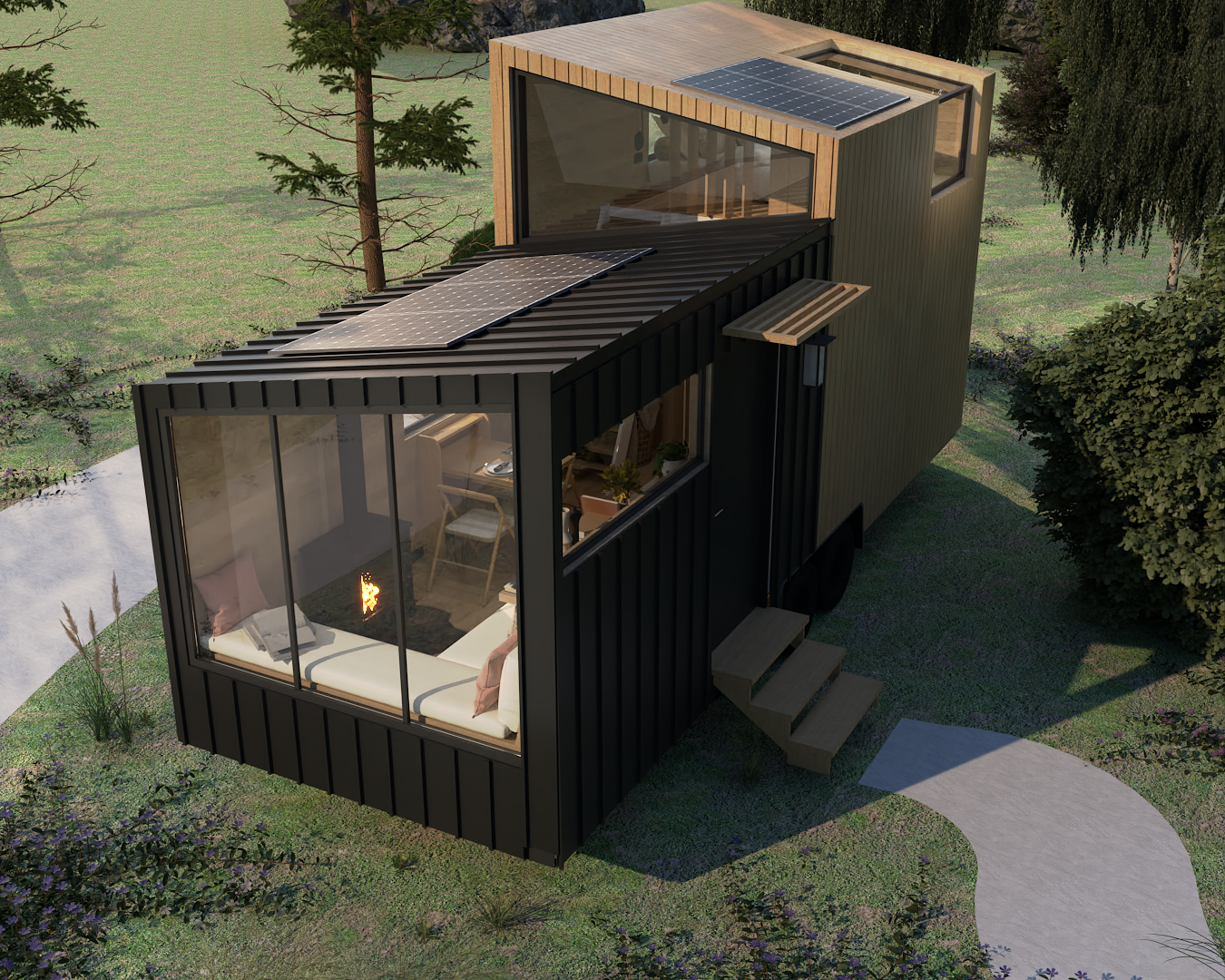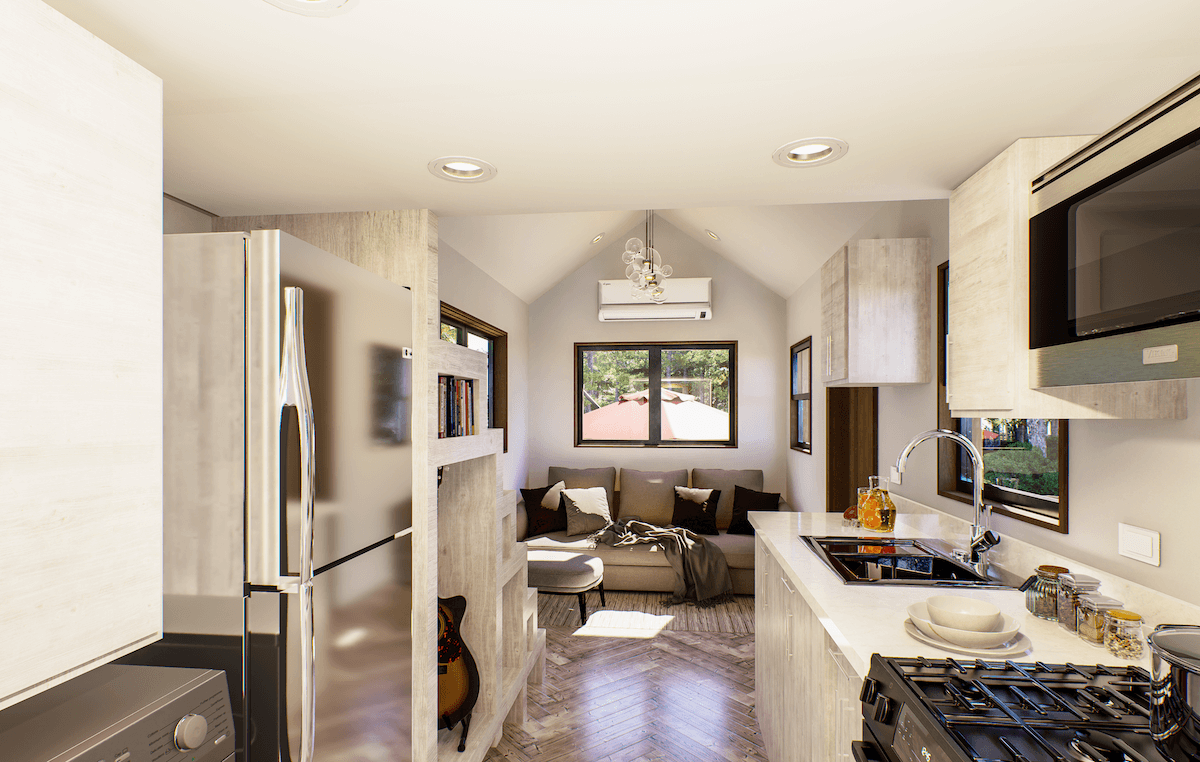Brighten your tiny house by layering dimmable ambient, task, and accent light. Use slim edge-lit disks or wafer downlights at 2700–3000K, plus micro-spotlights for art. Bounce light off ceilings with high-placed sconces and uplights to erase shadows.
Maximize daylight with light-filtering shades, pale warm neutrals, and mirrors. Add under-cabinet and toe-kick LEDs, low-profile track in kitchens, and smart scenes with motion sensors. Choose high-CRI bulbs, matte finishes, and tidy controls to make every inch glow—and even smarter.
Key Takeaways
-
Layer ambient, task, and accent lighting; use dimmable ceiling panels, under-cabinet strips, and micro-spotlights to add depth without clutter.
-
Maximize daylight with light-filtering shades, pale warm neutrals, and strategically placed mirrors or lacquered surfaces to amplify brightness.
-
Choose slim-profile fixtures—edge-lit disks, wafer downlights, and linear bars under shelves or toe-kicks—for space-saving illumination.
-
Maintain warm, consistent color temperatures (2700K lounges, 3000–3500K kitchens) and high-CRI LEDs; bounce light off ceilings to erase shadows.
-
Add smart controls with scenes, motion sensors, and sunrise/sunset automations for flexible, energy-efficient lighting tailored to tiny living.
Layer Ambient, Task, and Accent Lighting for Depth
Even in a compact footprint, layering ambient, task, and accent lighting gives your tiny house visual depth and functional clarity. Start with dimmable ambient light: low-profile LED ceiling panels or slim track heads create an even base without crowding sightlines. Add task fixtures where you work—under-cabinet strips for prep, a focused sconce by the sofa, adjustable clamp lights in the loft. For accent, aim micro-spotlights at art, open shelving, or a textured wall to sculpt shadows and add dimension.
Choose warm-to-neutral color temperatures for design harmony: 2700K in lounging areas, 3000–3500K in kitchens and desks. Keep luminaires cohesive in finish and scale. Hide wires, use plug-in sconces with cord covers, and prioritize layered lighting control with smart dimmers and compact, multi-zone switches.

Maximize Daylight With Light-Filtering Shades and Reflective Surfaces
While square footage stays tight, you can make daylight feel generous by softening it and bouncing it deeper into the space. Choose light-filtering shades—linen weaves, cellular fabrics, or solar roller screens—that temper glare, protect privacy, and still preserve views. Aim for pale, warm neutrals to maintain color accuracy and achieve daylight optimization from dawn to dusk.
Position reflective decor to amplify brightness without harshness. A low-iron mirror opposite a window doubles perceived depth; a mirrored backsplash or lacquered cabinet fronts push light across work zones. Opt for satin or eggshell wall finishes; they reflect softly and avoid hotspots. Use narrow window mullions, uncluttered sills, and translucent partitions to keep sightlines open. Combine these strategies and you’ll stretch natural light elegantly, maximizing clarity and comfort.
Space-Saving Fixtures: Slim Profiles, Flush Mounts, and Track Systems
Because every inch counts in a tiny house, choose lighting with minimal projection and maximum output. Favor flush mounts with shallow canopies and high-efficiency LEDs; they clear sightlines and keep lofts comfortable. Pick fixtures with slim profiles—edge-lit disks, wafer downlights, or slender sconces—to skim walls without snagging elbows or cabinet doors.
Use linear bars under shelves and toe-kicks to define zones without visual clutter. In the kitchen, low-profile track systems let you slide and aim heads over prep, dining, or desk surfaces as layouts evolve. Select matte finishes to quiet reflections and unify planes. Keep dimmable drivers accessible, and consolidate controls to reduce wall acne. Prioritize high CRI for true color, and match color temperature room by room for cohesive, calming light.
Bounce Light to Visually Raise Ceilings and Open Tight Corners
Lift your tiny house visually by bouncing light off ceilings and upper walls to erase shadows and stretch height. Aim uplights at junctions where wall meets ceiling; a soft, wide beam lifts planes and blurs edges. Place slim sconces high and use matte light colors—warm whites, pale oat, or mist gray—to maximize reflectance without glare. Angle adjustable heads toward corners to dissolve dark pockets and widen sightlines.

For an extra boost, add discreet ceiling mirrors or narrow mirrored bands above eye level to double the glow without clutter. Choose diffusers with high transmission and bulbs around 2700–3000K for cozy brightness. Keep finishes satin, not glossy, to avoid harsh hotspots. Test angles at night, then lock in placements that create a calm, floating canopy.
Under-Cabinet and Toe-Kick LEDs for Invisible Illumination
Even in a tiny kitchen, under-cabinet and toe-kick LEDs hide the light source and reveal only a clean, continuous glow. You gain task light without cluttering sightlines, and your floor plane floats, sharpening the room’s geometry.
Select under cabinet options that match cabinet depth: slim bars for uniform wash, edge-lit panels for glare control, or high-density tape for tight runs. Mount fixtures toward the cabinet front rail to eliminate backsplash scalloping and shadow lines. Conceal drivers inside an adjacent cabinet or a valance channel to keep profiles sleek.
Plan toe kick placement two to three inches behind the face to graze the floor, not your toes. Use aluminum channels with diffusers for durability, crisp edges, and easy wipe-downs. Keep runs continuous across appliances for a seamless line.
Warm Color Temperatures and Dimmers for Cozy, Flexible Moods
While square footage is tight, you can still sculpt atmosphere with warmth and control. Choose LEDs in the 2700K–3000K range to soften edges, flatter finishes, and make wood grains glow. Cooler temperatures (3500K–4000K) suit task bursts, but keep them limited to avoid a clinical cast. Use dimmers on every primary layer—ceiling, accent, bedside—so you pivot from focused to hush with one slide. Pair low-lumen lamps with high CRI bulbs to preserve texture and art tones.
Think color psychology: amber light calms, neutral white sharpens. Create mood lighting presets—dinner, reading, unwind—by dialing levels, not adding fixtures. Opt for warm-dim bulbs that shift from bright neutral to candlelike as they dim, mimicking dusk. Tuck controls near doors and the bed to streamline tiny-space flow.
Multifunctional Pendants and Plug-In Sconces for Adaptable Zones
Because every square inch has a job, choose fixtures that moonlight. Opt for pendants with swivel shades or rise-and-fall counterweights so you can shift beam spread from countertop to dining nook. Seek multifunctional design: a pendant with an integrated diffuser and focused downlight gives ambient glow and precise task light without clutter.
Plug-in sconces deliver adaptable lighting without hardwiring. Mount them on pivoting arms beside a sofa or loft ladder; swing them wide for reading, then park them flat to free circulation. Route cords along trim with low-profile clips, matching finishes to hardware for a clean line. Favor compact shades, matte opal glass, and warm metal tones to soften shadows. Position fixtures to overlap zones, reducing fixture count while amplifying purpose and polish.
Smart Controls and Scenes to Simplify Small-Space Living
Although your footprint is small, smart controls make it feel choreographed. Program scenes that layer task, accent, and ambient levels so your loft, galley, and lounge shift in one tap. Use smart lighting dimmers and tunable fixtures to tailor brightness from dawn routines to movie nights without touching a switch.
Mount low-profile keypads near entries; assign icons for Cook, Wind Down, and Work. A pocketable remote control or voice cue prevents midnight stumbles up the ladder. Motion sensors fade toe-kick LEDs on a timer, preserving calm and battery life. Geo-fencing can welcome you with a soft glow, then shut off when you leave. Group fixtures by activity rather than room, minimizing wall clutter and cables while keeping your tiny house visually serene and responsive.

Choose Bulbs That Flatter Finishes, Textures, and Skin Tones
Smart scenes do the choreography; the right bulbs do the beautifying. In a tiny house, pick bulb color with intention: 2700–3000K for cozy warmth, 3500K for balanced clarity at task spots. Aim for 90+ CRI so woods look rich, fabrics read true, and skin tones glow naturally. Test finish compatibility: warm bulbs deepen brass and walnut; neutral-white lifts chrome, white oak, and crisp paint.
Layer beam spreads. Narrow beams graze shiplap to reveal texture; wide floods keep countertops even. Use diffused globes in sconces to soften shadows on faces. Dim-to-warm lamps shift from bright prep light to amber evening mood without shifting colors oddly. Keep consistent color temperature across sightlines to avoid patchy walls. Always sample bulbs at night before committing.
Safe, Efficient Power Planning for Off-Grid and Tiny Homes
Before you hang a single fixture, map your power like a floor plan: list every light, its wattage, hours of use, and location, then size your system to that reality. Prioritize solar power with high-efficiency panels angled for your latitude, and pair them with right-sized battery storage so evening scenes stay consistent. Choose LEDs with superior energy efficiency, warm CCTs, and high CRI to preserve finishes and skin tones. Use low-voltage circuits for task strips and sconces, and dedicate a clean AC line for dimmable pendants.
Layer lighting control: scene presets, motion sensors for passage zones, and sunrise/sunset automations to stretch capacity. Protect everything with proper fusing, GFCI/AFCI where required, tidy cable runs, and labeled breakers. Monitor loads with a shunt meter to adjust habits gracefully.
Conclusion
With layered light, you’ll turn every inch into purposeful glow. Let daylight skim matte walls, then add slim fixtures, toe-kick LEDs, and plug-in sconces to sculpt zones without clutter. Bounce beams to lift ceilings, wash corners, and spotlight textures you love. Program simple scenes for cooking, unwinding, and guests.
Pick high-CRI bulbs that flatter wood, metals, and skin. Plan efficient circuits—on- or off-grid—to keep things safe, silent, and thrifty. Small space, big ambiance—beautifully lit.





Share: